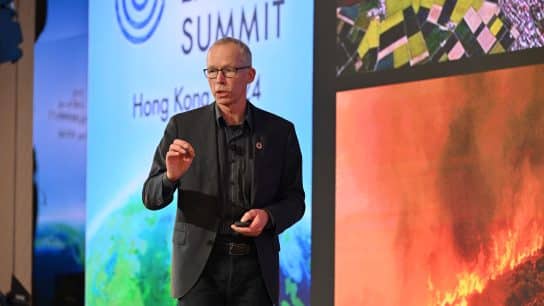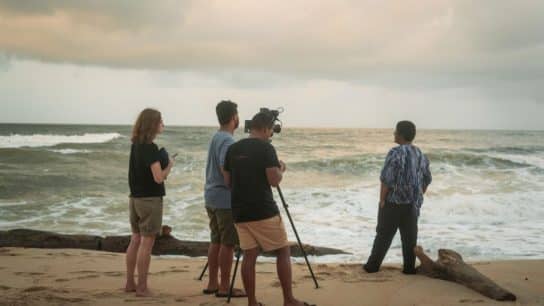In an exclusive interview with Earth.Org, Walid Al Saqqaf, co-founder and CEO of nature-based solution platform Rebalance Earth, and Amit Ghosh, Chief Information & Services Offices and Head of Asia Pacific of enterprise blockchain technology provider R3, discuss the importance of biodiversity and the necessity to implement nature-based solutions such as nature credits to protect keystone species and alleviate the climate crisis.
—
Biodiversity Is at Risk
According to the International Monetary Fund (IMF), great whales are typically valued at US$50,000 for their meat. Still, they are actually worth $2 million if kept alive due to the carbon sequestration services they perform in the ocean.
This is an illustration of a key point that is missing in most climate change conversations – the remarkable benefits of biodiversity.
The World Economic Forum estimates that roughly half of the global GDP, or about $44 trillion of economic value, depends on the natural world in some way, meaning its destruction also carries an enormous financial toll.
Biodiversity is often referred to as the “web of life” because it shows how all the species work together to support life and ecological balance on Earth. Our planet is home to approximately 8.7 million species and while humans make up just 0.01% of life on Earth, their activities are compromising entire ecosystems and killing millions of animals and plants every year. Our modern lives and patterns of overconsumption are putting a strain on the planet’s natural resources.
According to the WWF’s Living Planet Report 2022, since 1970, 69% of our planet’s wildlife population has been lost due to land-use change, over-harvesting, habitat fragmentation, invasive species, and pollution. Data from the World Economic Forum suggests that 75% of our land has been fundamentally altered, 66% of oceans negatively impacted, and 85% of wetlands lost.

Image 1: Biodiversity loss by region (WWF).
To learn more about viable nature-based solutions that support biodiversity conservation while simultaneously contributing to carbon emission reduction, Earth.Org spoke to Walid Al Saqqaf, co-founder and CEO of Rebalance Earth, and Amit Ghosh, Chief Information & Services Officer and Head of Asia Pacific at R3, a leading enterprise blockchain technology provider.
A Partnership to Develop Nature Credits
The IMF study about the economic value of great whales represented a turning point in Al Saqqaf’s career. When confronted with the findings, the startup developer decided it was time to change something.
“I realised three things,” he said. “First, we only value nature when it’s dead and not when it’s alive. Second, I refuse to accept that my daughters grow up in a world with such crummy values. And finally, I think I know how to solve this.”
Motivated to find a nature-based solution to protect biodiversity while simultaneously alleviating the climate crisis, Al Saqqaf co-founded Rebalance Earth, a new nature-based solution platform that allows its users to purchase ecosystem service credits produced by forest elephants and earn returns in the form of carbon credits and biodiversity credits.
“With our work, we want to help develop a nature-based economy where it becomes more valuable to keep nature alive than to kill it,” he explained.
Through its partnership with R3, a blockchain technology provider that specialises in the creation, distribution, and tracking of digital assets, Rebalance Earth integrates services performed by nature into the market by creating high-integrity nature credits. These credits, Al Saqqaf explained, have three, tightly interconnected aspects: climate change, biodiversity, and global communities.
“Our mission is to create high-integrity nature credits that protect and grow biodiversity, support carbon capture, and generate prosperity for the communities that preserve nature.”
R3 makes the whole process of selling and buying these credits more efficient. According to Ghosh, this efficiency is guaranteed through smart contracts, which can track and enable the movement of assets across different bodies, as well as through the use of cryptography to make sure that data is tamper-proof. This ensures the company buying the credit that the data obtained from the forest is reliable and thus that they are paying for the right cause.
You might also like: What Are Nature-Based Solutions And How Can They Help Tackle the Climate Crisis?
Carbon Capture Technologies vs. Nature Credits
Building carbon capture technologies (CCTs) remains one of the most popular ways to solve the existential threat our planet is facing. CCT refers to anthropogenic activities that remove carbon dioxide from the atmosphere and store it durably in geological, terrestrial, or ocean reservoirs, as well as in products. Carbon capture builds on the ability of so-called natural ‘carbon sinks’, like the ocean and forests, to absorb or store carbon, often enhancing it through the use of technology.
However, there is also another form of technology that allows us to protect biodiversity and slow down climate change, a concept that has gained traction only recently: nature. Concretely, this can be done by selling ecosystem services provided by biodiversity to produce carbon offsets, which in turn support the livelihoods of local communities.
Rebalance Earth decided to focus specifically on keystone species, including the forest elephant, the gorilla, and the caribou, one of Canada’s most recognisable species. Such species are regarded as “ecosystem engineers” as they “have been shown to respond to, and create, habitat heterogeneity”. In practice, they help boost diversity by creating ecological niches for other species whether flora or fauna.
The ecosystem services platform surveyed 23 large companies across 8 industries to find out how much they would be willing to pay for a high-integrity nature credit that provides them with biodiversity, carbon, and a human element. The answer was $40.
“Over 80% of the $40 goes to pay park rangers’ salaries, to provide free health care and education to local communities, and into a micro-fund that invests only in women for them to set up their own business,” Al Saqqaf clarified. “This is truly a holistic solution.”
The reason why Rebalance Earth believes nature credits are a better solution than carbon capture technologies lies in the fact that they have a ripple effect. Through R3’s institutional-grade blockchain technology, Rebalance Earth makes use of capital generated from the biodiversity credits into projects that support the UN Sustainable Development Goals.
“If you spend $40 dollars on CCT, it will absorb the carbon from the atmosphere,” explained Al Saqqaf. “However, if you spend $40 dollars on an orangutan, a great whale, a forest elephant, or a wolf, you’re not just saving a species from extinction, you’re also getting the carbon sequestration, the biodiversity impact because they’re providing those ecosystem services for the entire ecosystem, you’re financing the economic development of a local community who now become consumers themselves, who spend money, who pay taxes. You’re actually lifting a whole nation up.”
Unlike carbon or biodiversity offsets, which are payments made by a business to compensate for its damaging impacts on location-specific ecosystems, buying a nature credit means investing in an opportunity to become stakeholders of nature while also getting a financial return in the form of future carbon and biodiversity credits which are tradable in the market.
The R3 and Rebalance Earth partnership is set to launch early this year in a number of jurisdictions across the world and with a number of species.
Final Thoughts
Ahead of last month’s flagship biodiversity summit in Montreal, or COP15, the United Nations Development Programme (UNDP) and International Institute for Environment and Development, a UK-based think tank, released a report backing biodiversity credits, or ‘biocredits’, as a way to “incentivise nature conservation and restoration to benefit marginalised groups living with nature.”
“As a purely positive investment in nature, biocredits are distinct and are preferred to biodiversity offsets, which can cause net damage to biodiversity,” the paper reads.
COP15 ended with a historic deal to protect the world’s biodiversity and provide finance to restore habitats in developing countries and sent a clear message to the world about the importance of protecting and preserving nature.
With the clock ticking to mitigate the impacts of the climate crisis and biodiversity loss and reverse global warming, nature credits can play a key role in our efforts to reach the shared global goal of net zero.
You might also like: Did COP15 Succeed or Fail?


















